- Author: Christine Casey
When gardeners think of good bee plants, many choices in the mint (Lamiaceae) family come to mind. A favorite of many folks (and many bees!) is Spanish lavender, Lavandula stoechas. Among the lowest water users of the lavenders, there are a few tried-and-true cultivars and many new introductions. Primarily a nectar source, attributes for the bee garden include late winter bloom (followed by repeat bloom through the summer with regular deadheading) and great bee attractiveness. All need full sun and well-drained soil. To give an idea of relative attractiveness, our largest planting of 'Anne's Purple' is next to a similar-sized planting of 'Hot Lips' sage. When both are blooming, there are no bees on the sage while the lavender is heavily foraged.
Spanish lavender cultivars in the Honey Bee Haven: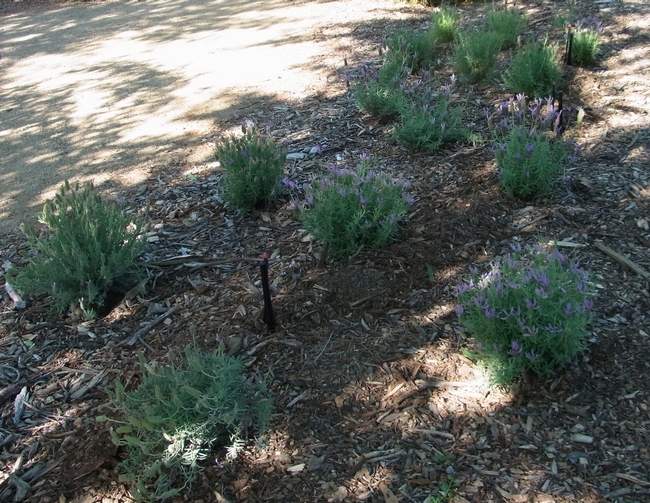
- 'Anne's Purple'. Among the largest cultivars (about 30 inches tall and wide), this one has been a vigorous grower at the Haven, where it is a bee favorite.
- 'Dedication'. Newly planted this winter. A cultivar of the subspecies Lavandula stoechas pedunculata, it was developed in New Zealand and is similar to 'Anne's Purple' in size.
- 'Kew Red'. I planted this a year ago because of the interesting raspberry-colored flower. I removed it this winter as it did not prove to be as attractive to bees as the purple-flowered cultivars.
- 'Lutsko's Dwarf'. Newly planted this winter. Grows to about 12 inches by 12 inches and a great choice for containers.
- 'Madrid Purple'. Newly planted this winter. This is part of a series; there's also 'Madrid Blue', 'Madrid Pink', and 'Madrid White'. On the smaller side, these reach about 18 inches by 18 inches and are also an option for containers.
- 'Mi Casa'. Newly planted this winter. Not much information available.
- 'Otto Quast'. This one has not been as vigorous or as attractive to bees as the other cultivars at the Haven.
- 'Winter Bees'. Smaller in stature (about 18 inches tall and wide), it blooms for a long time (it's the first to bloom in late winter) and is very attractive to bees.
At the Haven, Spanish lavender seems to be more attractive to bees than our other lavender, Lavandula 'Goodwin Creek Grey'. I have not yet tried and of the white-flowered lavender cultivars.
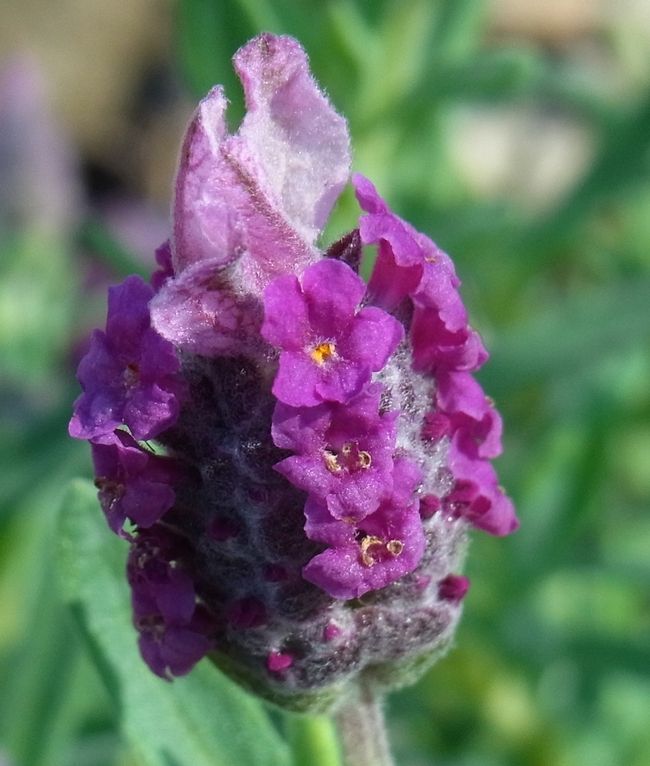



- Author: Christine Casey
There will be lots happening at the Haven this year for bee, plant, and nature lovers. In addition to the garden events listed below, we'll also be at other locations: we'll have a display at the Yolo Basin Foundation's Duck Days on February 21, and I'll be speaking about water-wise pollinator gardening on March 11 at the City of Woodland's Water-Wise Wednesdays program. On April 18 I will have a native bee display and bee gardening information at Wildflower Wonders, the spring plant sale of the Sacramento Valley Chapter of the California Native Plant Society.
Keep those bee gardens growing!
March 28
The California Center for Urban Horticulture's Create a Living Landscape workshop will conclude with a tour of the Haven. We'll have bee houses for sale to help support the garden.
April 11
The Haven will be a stop on the Gardens Gone Native tour sponsored by the Sacramento chapter of the California Native Plant Society. Docents will be on hand from 10am to 3pm to answer questions about the garden's native plants and native bees.
April 23. Please note this is a revised date for this event.
Native bees lunchtime drop-in. New at the Haven this year are lunchtime drop-in days, each featuring a topic related to the garden with docents present to answer questions or give informal tours. Stop by anytime between 12 and 1:30pm to view native bees and their host plants; native bee houses will also be for sale.
May 2
The Haven is five years old! Join us between 10am and 2pm for a fifth anniversary celebration. There will be informal tours and lectures, an observation honey bee hive, and lots more.
May 8
National Public Gardens Day open house. Join us between 5:30 and 7pm for informal tours, information about bee watching and ID, and an observation honey bee hive. We'll have bee houses for sale and free plants (while they last) to get your bee garden started.
May 9
The Haven will host a reception as part of the Keeping Bees Healthy symposium sponsored by the Honey and Pollination Center at the Robert Mondavi Institute and the UC Davis Department of Entomology and Nematology. The symposium is intended for a general audience at the level of high school students and up; student registration is only $15!
June 19
National Pollinator Week open house. Join us between 5:30 and 7pm for informal tours, information about bee watching and identification, and an observation honey bee hive. We'll have bee houses for sale and free zinnia seeds (while they last) to help your bee garden grow well into the fall.
July 17
Native ants lunchtime drop-in. New at the Haven this year are lunchtime drop-in days, each featuring a topic related to the garden with docents present to answer questions or give informal tours. Stop by anytime between 12 and 1:30pm to view and learn about native ants. Like bees, ants are social insects with amazing biology and life histories.
September 25
Honey bees lunchtime drop-in. New at the Haven this year are lunchtime drop-in days, each featuring a topic related to the garden with docents present to answer questions or give informal tours. Stop by anytime between 12 and 1:30pm to view honey bees and their fall host plants as well as an observation bee hive.
October 2
Fall open house. Join us between 5:30 and 7pm for informal tours, information about bee watching and identification, and an observation honey bee hive. We'll have bee houses for sale to help support the garden.
- Author: Christine Casey
From a human perspective, we don't often think of February as an important time for flowering plants, but for bees it's another matter. Honey bees are out foraging when it's sunny and over 55 degrees, while native bumble bees that become active early in the year are in need of pollen and nectar resources to grow their colonies. The solitary bee Osmia lignaria -- an important alternate pollinator in early fruit and nut crops -- is also active.
A group of native plants that provide resources for all these bees with their February flowers are the currants. The first to bloom is chaparral currant, Ribes malvaceum; we grow the cultivar 'Dancing Tassels' at the Haven. This plant starts to flower in January and will continue its showy display through February. In addition to bees, look for lots of hummingbirds on this plant.
Following close behind is fuchsia-flowered gooseberry, Ribes speciosum. Primarily a hummingbird plant, the photo shows how accessible the pollen is for small bees. We don't grow this at the Haven, as it has large thorns that could be a visitor hazard. It can be espaliered up a fence, where the thorns can serve as a living security system. Another consideration when siting this plant is that it copes with our summer heat by losing its leaves in July.

Next to bloom, and the most commonly planted, is the evergreen currant, Ribes viburnifolium. This plant's stems tend to arch over and root where they contact the ground, creating a dense groundcover. I've often seen this plant placed in full sun, which it can't tolerate, leading to leaf scorch and poor growth. A better location is under native oaks or any other dry, shaded spot. Although the flowers are not showy, they are still valuable for bees.
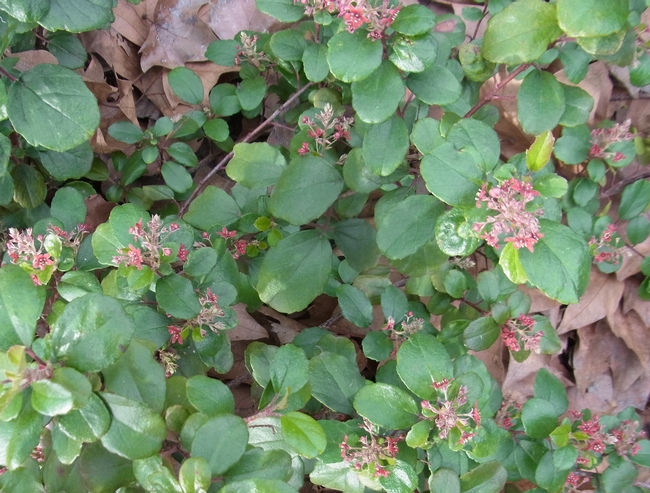

The last plant in this group to bloom is golden currant, Ribes aureum, which will start to flower around the middle of the month. Its bright yellow flowers make it a good, low-water substitute for non-native forsythia. It can tolerate a range of watering regimes; at the Haven we grow it in both a wet area next to a bee waterer and in a dry area under a valley oak. It tends to stay smaller and lose its leaves earlier (around late August) in the dry area but still flowers well. 

- Author: Christine Casey
Manzanitas (Arctostaphylos spp.) are a diverse group of California native plants that serve as a great winter resource for bees, especially native bees that fly early such as Osmia spp. and Bombus melanopygus. They are shrubs (mostly) and groundcovers (a few) that should be used in more California gardens. The waxy green leaves, peeling bark, smooth reddish to mahogany branches, and upright leaves are attractive throughout the year. These plants have stomates on both sides of the leaf so leaves are held perpendicular to the ground, rather than parallel, to minimize sun exposure and water loss. Some begin flowering in late fall, while most flower in January and February. In my own garden these held up well to drought this summer without any supplemental watering.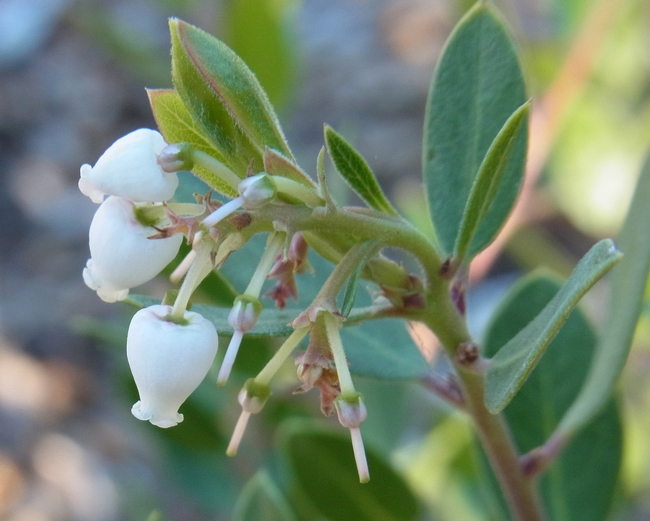
The California Native Plant Society has a nice article on this group; I also use the websites of Las Pilitas Nursery and California Flora Nursery to learn about new species for inclusion in the Honey Bee Haven.
According to California Bees and Blooms, two of the best for bees are the Arctostaphylos densiflora cultivars 'Sentinel' and 'Howard McMinn'. These two are also among the easiest to grow and fastest to reach mature size; the former tends to be upright while 'Howard McMinn' tends to be more rounded in shape. It is also the most adaptable; this UC Davis Arboretum All-Star can tolerate heavier soils than most manzanitas as well as some summer irrigation. Two other great cultivars for gardens are 'Austin Griffiths' and 'Sunset'.
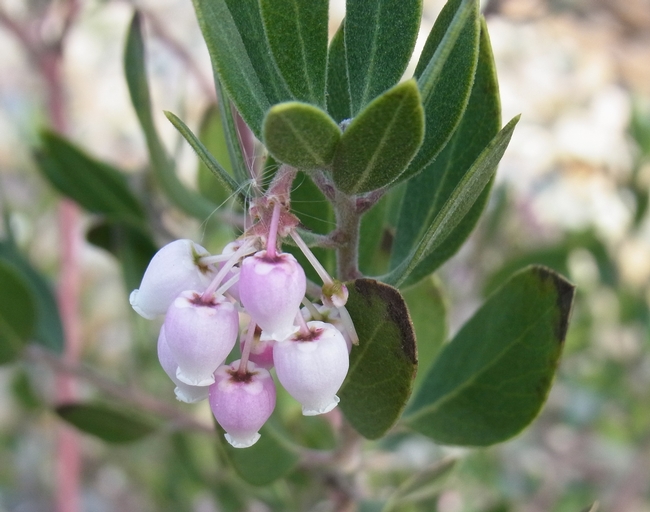


Manzanitas host a gall aphid, Tamalia coweni. The aphid lays eggs in manzanita leaves and hormones secreted by the developing aphid induce formation of a gall on the leaves. Cut these open to view the developing aphids inside; they are not considered to be a plant pest.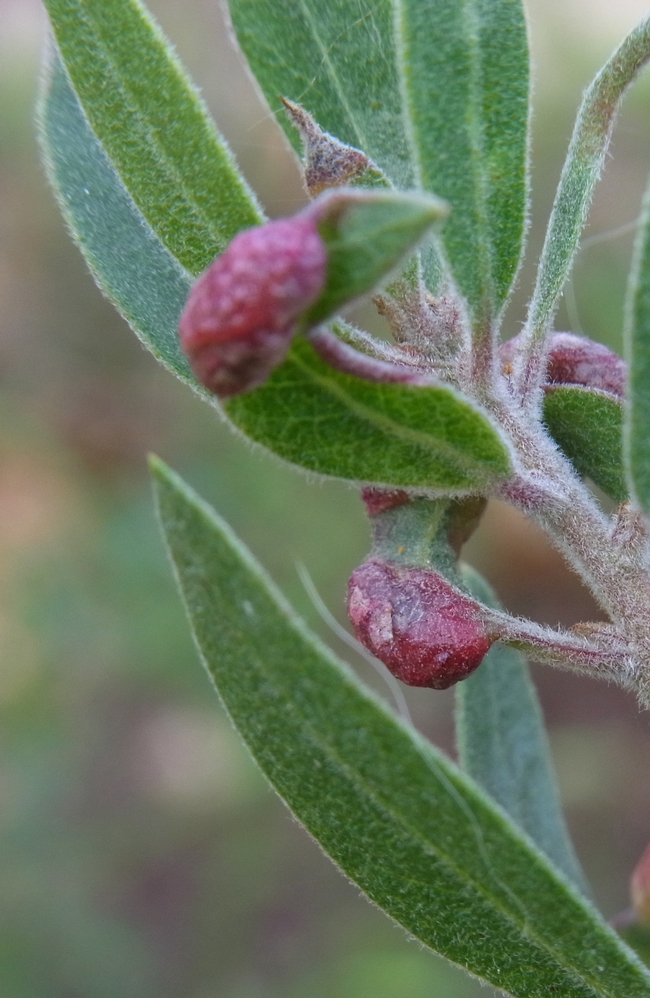
- Author: Christine Casey
On Veteran's Day we honor our military veterans. Like our bees, they work hard and make contributions that many of us take for granted. In recognition of their service, some agricultural and beekeeping organizations provide financial support and training to veterans who would like to make beekeeping their profession.
Our central California weather is conducive to year-round honey bee activity, so including plants that are blooming on Veteran's Day in your bee garden will support honey bees and the occasional native bee that may still be active. On any sunny day with temperatures over 55 degrees Haven visitors will see bees in the garden. Here are some of the red, white, and blue flowers you'll see them foraging on this time of year:
Red (bees do not see red but will use these flowers):
Autumn sage (Salvia greggii) cultivars ‘Hot Lips' and ‘Lipstick'
Zinnia (Zinnia elegans)


White:
Gaura (Gaura lindheimeri)
Zinnia (Zinnia elegans)
California buckwheat (Eriogonum fasciculatum)
Early-blooming manzanitas (Arctostaphylos spp.). The cultivars ‘White Lanterns' and ‘Howard McMinn' are the two earliest bloomers at the Haven.


Blue (shades of blue to purple):
Bush germander (Teucrium fruticans)
Rosemary ‘Mozart' (Rosmarinus officinalis ‘Mozart'); this rosemary cultivar has outstanding deep purple flowers
Mexican sage (Salvia leucantha); give it space, as it can reach up to eight feed wide in bloom
Aster (New World species are now in the genus Symphyotrichum, while Old World species remain in the genus Aster). All of the Haven's asters are New World species.


Click here see a complete list of plants in the Honey Bee Haven.




